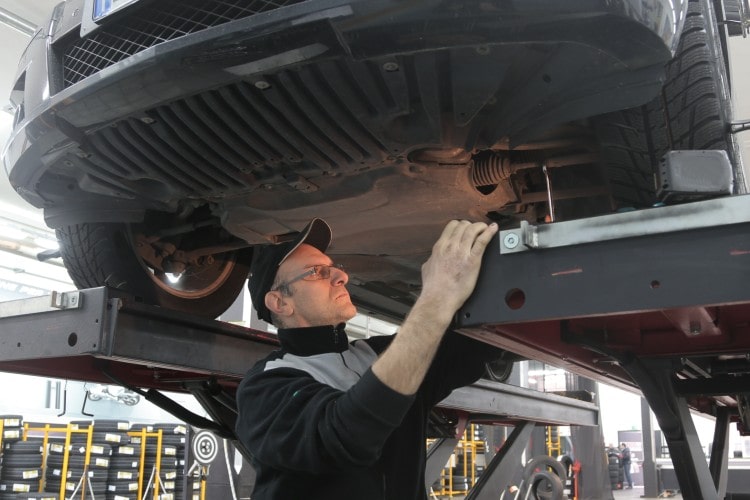When you own and manage a fleet of commercial vehicles, the importance of regular maintenance cannot be understated. You need your fleet in top working order if you’re to keep customers happy, employees safe, and business thriving. To do that, you’ll need to do more than be timely about basic servicing – you need to have a comprehensive fleet maintenance plan.
Due to factors such as a company’s industry, size, and location, proper fleet maintenance cannot be solved with a one-size-fits-all approach. Still, certain underlying themes are a common factor with most successful commercial vehicle maintenance operations. Let’s take a look at some of the basic principles to keep in mind when creating or streamlining a new fleet maintenance plan.

To put it simply, fleet maintenance is the regular servicing of your company’s vehicles. The term can encompass oil changes, tire rotations, fluid flushes, and other routine maintenance items required by the combustion engines powering most vehicle fleets.
It’s important to note that fleet maintenance isn’t about chasing after and fixing mechanical issues; it’s about following the factory-recommended service intervals and taking a preventative rather than a reactionary approach to mechanical upkeep. This may sound easy enough, and it might be if you only have a couple of work trucks or vans on the roster. However, fleet maintenance becomes a much more intricate process as your business grows and you acquire different vehicles with equally different servicing schedules.
Why is fleet maintenance so important? There’s a long list of valid reasons, but the biggest benefits include ensuring employee safety, reducing legal liability, maintaining compliance with federal standards, and reducing operating costs and revenue losses related to your fleet. Let’s take a look at each of these in turn:
This is a big one, both from an ethical standpoint as well as the potential cost of liability, were anything to happen to an employee operating a neglected machine or vehicle. When your vehicles aren’t up to date with maintenance, there’s a chance that something could happen while an employee is behind the wheel. What if you put off replacing the pads and rotors in a company truck and the brakes fail? What if a brittle hydraulic line blows out on a dump vehicle? Not only could someone be at serious risk of injury from such a failure – it could also be grounds for legal action against your business.
Typically, the court of law says that it’s the company’s legal responsibility to keep their vehicles in good condition. Were an accident to happen that was deemed the result of the company’s inadequate maintenance practices, the company could be found negligent in court. This risk can be avoided simply by staying abreast of the basic servicing needs of your fleet.
If you’re a trucking company, you know of the Federal Motor Carrier Safety Agency. For those unfamiliar, the FMCSA regulates and oversees the safety of large commercial vehicles like semi trucks and buses. They set rules like how long a driver can stay behind the wheel and the usage of electronic driving logs (ELDs).
They’re also the ones enforcing safety inspections of commercial vehicles, and they have established strict guidelines relating to vehicle repairs and maintenance. For instance, in the regulations for large passenger buses, the opening section states clearly that “Every motor carrier shall systematically inspect, repair, and maintain, or cause to be systematically inspected, repaired, and maintained, all motor vehicles subject to its control.” Get caught violating the FMCSA rules, and you’ll likely be hit with a fine that’s typically thousands of dollars per violation.

It sounds obvious, but the vehicles in your business are directly impacting your revenue. When a vehicle that isn’t properly maintained suddenly needs to be sidelined for unexpected repairs, you’re not just stuck with an unplanned expense – you’re also paying hidden costs stemming from unearned revenue and lost work.
Think of it like this: you own a fleet of ten work vans that spend 8-10 hours on the road each day attending on-site customer calls. Each van makes five customer visits per day. When all ten vans are running just fine, there’s no issue. But when one van breaks down, it’s sidelined until it gets fixed, and with it goes the five paying customers it would have otherwise served that day.
Being unable to serve those five customers represents a sudden 10 percent reduction of your usual daily revenue. You’ll incur this loss for every day the van is out of commission. And while one day of lost revenue may sound manageable, what if the van can’t be fixed for a week, or even a month? With proper fleet maintenance, you can minimize the risk of key vehicles being hamstrung by big repairs.
It costs money to operate any vehicle, but those costs rise when that vehicle isn’t being properly cared for. Neglecting common maintenance items like tune-ups and oil changes can cause an engine to run poorly, which, in turn, can lead to excess mechanical wear and increased fuel consumption. What’s more, you likely won’t even notice from behind the wheel how simple things like old spark plugs or dirty engine air filters are enough to meaningfully decrease a vehicle’s fuel economy. Across thousands of miles and multiple vehicles, the financial impacts of this can be significant.
Enacting and enforcing stringent fleet maintenance procedures can ensure that simple, regular repairs aren’t overlooked. Putting a system in place to monitor your fleet for things like proper tire inflation might sound minor, but it can literally pay dividends over time.
Regularly maintaining your commercial vehicles is the key to great fleet management. At MPC, our durable rating plates and other data plates and nameplates can relay critical information at a glance, allowing drivers, fleet managers, and service techs to easily determine key vehicle specs. Since our labels are resistant to weathering, abrasion, and general abuse, they’ll hold up no matter what you put your transportation and heavy equipment through.
Our labels are also compatible with fleet management software, helping you track and monitor your vehicles with ease. If you haven’t yet incorporated such software into your fleet management plan, now’s the time to do so, as they make it easy to track all relevant metrics in one place. Most software can return a highly detailed analysis of your vehicles, giving you breakdowns of usage, run time, and any maintenance alerts that your fleet manager will want to know. A comprehensive software like this makes it far more manageable to track a fleet of any size, enabling you to cut vehicle downtime to a minimum and ultimately reduce your cost per mile.
Of course, none of this works without company-wide support. To get proper fleet maintenance to stick in your organization, you’ll need buy-in from the whole team, from the actual drivers to the head fleet manager and everyone in between. You don’t want to discover that one of your vehicles was overdue for maintenance only once your driver is calling you from the side of the road while waiting for the tow truck – you want to know as soon as someone notices something may be amiss.
Foster communication and get buy-in from the team, and you’ll be well on your way to putting a foolproof fleet-management plan into action.
Our sales engineers are experts in automatic asset tracking, tagging and identification,a nd can answer all your questions. Get in touch now.
Lets Talk ›